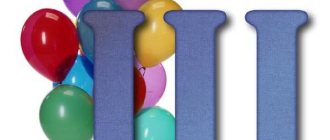The magical age from two to five flies by quickly, when parents are thrilled by any new word mastered by their home linguist. Baby babble seems richer and richer than classic adult speech. And the parents themselves are not averse to lisping with their child in his bizarre language, wittingly or unwittingly creating situations for the incorrect formation of speech and pronunciation skills.
Writing and pronunciation of the letter and sound L
Pronunciation L: norm and deviations
For correct articulation, it is necessary that the teeth are not clenched and there is a gap between them. The tip of the tongue is slightly tense and touches the gums of the upper front teeth; it is lowered in the middle and on the sides, and slightly raised at the base. A stream of air comes from both sides between the tongue and cheeks. The vocal cords are used, which give the sound a ringing quality.
Incorrect pronunciation is possible when the position of the speech organs is disturbed:
- the tongue goes too deep into the oral cavity, and its tip does not touch the gums and upper teeth. Instead of L it turns out Y (“shovel” - “yopata”);
- at the moment of pronunciation, a sharp inhalation occurs and the cheeks are involved in the process - it turns out F;
- The lower lip is close to the upper teeth, the tip of the tongue lies at the bottom of the mouth. The result is the sound B (“came” - “stitch”);
- When you exhale, the air flows through your nose. A sound similar to “ng” (“lamp” - “ngampa”) comes out;
- the labial muscles tense instead of the tongue muscles - bilabial pronunciation. It turns out U instead of L (“boat” - “boat”);
- interdental sound is noted. It sounds almost the same as a regular L, but the tip of the tongue is located between the teeth, and not behind the upper incisors.
It is also possible to replace L with D, Y, soft L (“class” - “class”) or complete loss of sound (“fox” - “isa”). In some cases, they first put R, and then - then the child says instead of “moon” - “rune”, and then they put L.
Basic recommendations and exercises
Each “training” day will need to start with a warm-up.
This is important in order to warm up the child’s articulatory apparatus before performing the exercises. For example, you can ask your baby to “brush” his upper teeth with his tongue
To do this, you need to smile and walk the tip along the inner surface of the row. At the same time, you need to make sure that his jaw remains in place. Another warm-up option can be regular clattering. The fact is that the technique of making the sound characteristic of a horse is somewhat reminiscent of the pronunciation of “R”. And you can laugh with your baby while doing the exercise - who sticks out their tongue further. His trick is to try to say something with this position of the tongue.
It is important to complete all assigned tasks together. The child must see the articulation and facial expressions of the adult, and not just hear
In childhood, the first thing everyone learns is to imitate. The main thing is to be patient, as some exercises can take several months to perform correctly. Under no circumstances should you give up and stop smiling. You really need to treat exercise like a fun game. More precisely, make them like this. And then, after establishing the correct pronunciation of the sound, it will be possible to move on to syllables and simple words. If all the above conditions are met, parents will be able to achieve tangible success with their child. One day, he will easily and simply be able to master continuous speech with a difficult-to-pronounce letter. Don't forget to celebrate this occasion with a delicious cake.
Advertisement
Reasons for violations
There are many possible provoking factors:
- Breathing disorders during speech, for example, with a pathology such as a decrease in lung volume or weakness of the respiratory muscles;
- Problems with speech hearing (the child does not perceive speech well);
- Weakness of facial expressions and tongue muscles;
- Incorrect structure of the frenulum under the tongue.
Often, birth injuries and delayed mental and motor development in infancy and preschool age lead to problems in articulation. It is important to contact a speech therapist in a timely manner to correct the situation.
The stages of setting the sound L are preparation, direct correction and consolidation. It is important to do everything step by step, practicing each step.
When is the help of a speech therapist needed?
Sometimes home exercises to correct sounds do not produce results, the reasons may be the following:
- Russian is not the family’s native language, so adults speak with an accent;
- the baby was unable to master correct pronunciation after long exercises;
- someone from the adult environment has a diction defect and cannot conduct classes.
Since you couldn’t fix the problem yourself, you should seek the help of a specialist. Producing sounds is a special skill that only comes with experience.
The speech therapist will examine and listen to the little patient and offer to attend individual classes or group training. The task of parents is to be able to captivate the child by stimulating him to attend trainings. Even if the baby is not yet successful, he still needs to be praised and supported emotionally.
Preparation for setting L
Before starting classes, demonstrate to your child the correct sound of L. Pronounce a few words clearly so that you can see how the tongue and lips are positioned. Name a few words with the L sound and ask the student to determine which part of the word contains the required phoneme.
An integral element of classes on setting L are preparatory exercises:
- "hammock". The tip of the tongue rests on the front teeth, and the tongue itself arches like a hammock. You need to hold the muscles in this position for several seconds;
- "lollipop". Using a wide tongue, you need to lick your upper lip from top to bottom, while keeping your lower lip motionless. Gradually increase the speed and ask the child to add “bl-bl-bl” sounds when performing the technique;
- "horse". This is a playful way of setting L, beloved by all children. The wide tongue rises and clicks across the palate. The mouth is slightly open, the lower jaw is motionless;
- "swing". Ask your ward to smile widely with an open mouth and rest the hard tip of the tongue first on the back surface of the upper front teeth, and then on the lower ones. 5 – 10 repetitions are required;
- "fungus". The back should be pressed against the upper palate so that the frenulum is slightly stretched. We fix the position for 5 – 10 seconds.
It is worth adding general strengthening exercises - roll your tongue into a tube, “brush” your teeth with it, alternately touch your cheeks. The entire complex must be completed at least 14 days before the start of L’s treatment with a speech therapist.
The feasibility of speech therapy classes
Some parents do not think about how to teach their child to say the letter L. They do not consider the defect to be something serious, but in adult life it will become the basis of complexes and worries.
Important! It is better to correct speech disorders in preschool age, then the process will take a little time.
Causes, diagnosis and clinical picture of mental retardation in ICD 10 coding in children
If parents do not know how to correctly teach their child to pronounce the letters L and R, then they should contact a specialist. A speech therapist will be able to correct this problem and develop the desired pronunciation.
How many lessons does it take to produce sound [l]
It is impossible to say with certainty how many lessons will be required to eliminate the defect. Sometimes sound production takes one session, in other situations it will take more than 30-40 meetings.
It all depends on the characteristics of the child, his motivation and the interest of the parents. Learning to pronounce the sound [l] is not so easy, since a preschooler gets used to a certain stereotype. Due to their age, it is still difficult for children to perceive learning activities.
Staging methods
First, the articulation of a soft sound is honed, and then a hard one. They use various methods of production: by imitation, mechanical, from other sounds, as well as breathing and articulation exercises. Individual staging is always more effective than working in a group.
By imitation
This is the most common and simplest staging technique and can be done at home. It is necessary to show several times how to correctly position the tongue and lips when pronouncing L correctly. Then the child repeats. To control, touch your cheeks - they should vibrate slightly.
With this setting, the child is asked to feel a warm wave of air on the palm of his hand when pronouncing sounds. Pictures depicting the letter itself and the articulation technique are useful - a visual image helps to quickly master the skill.
Mechanical method
This is a widely used method. Mechanical placement involves the use of auxiliary means - fingers, a spatula, a probe, a wooden stick or the handle of a teaspoon to fix the speech organs in the correct position.
Possible correction options:
- You can create the necessary space between the sides of the tongue and the upper teeth for the correct direction of the air stream using a wooden stick placed across the tongue;
- Holding your lips in a smiling position with your fingers will help correct U to L with bilabial pronunciation;
- Pressing the pad of the thumb or the back of the hand on the dimple under the chin allows you to get a hard sound when pronouncing a soft one.
With a light massage with your fingertips it is easy to relax facial muscles.
From other sounds
In speech therapy there is a method of setting from A. The child pulls out the vowel and pushes the tongue between the teeth, then bites it in the middle. The sound A turns into a solid sound L.
It is possible to set a hard sound L through Y. You need to lightly bite the tip of your tongue and make the Y sound. If everything is done correctly, L will be heard.
There is a more complex variation. The tongue lies halfway between the teeth. You need to start exhaling forcefully. First we do it silently, then we add voice. We hear a noisy hard sound L, which over time becomes clear and distinct.
Why does a child pronounce a sound incorrectly?
The sound [L'] is considered complex and is the last to be mastered by the baby.
If by the age of 5 speech disorders persist, then perhaps the reason lies in the following situations:
- someone close to you pronounces “L” incorrectly, and the baby imitates him;
- poor phonemic awareness. A 3-5 year old child can already distinguish all types of consonants by ear: hissing, voiceless, voiced, etc. Even when he cannot pronounce them correctly, he must correctly indicate the mouse or bear in the picture. If the baby has undeveloped phonemic hearing, in the future there will certainly be difficulties with writing and reading. You need to be able to distinguish all sounds by the age of 4;
- the family speaks 2 languages. This is always a risk for the development of speech disorders. In this situation, it is considered normal if both languages are acquired with a slight delay;
- short frenulum of the tongue. Normally, for 5-6 year old children, its length should be 8 cm. If shortening or thickening of the frenulum is detected, then there will definitely be difficulties with the pronunciation of “L”. The problem can be solved either surgically or conservatively with the help of articulatory gymnastics.
A consultation with a speech therapist or dentist will help you find out the cause of incorrect pronunciation.
Experts note that only 10% of children aged 4-5 years can clearly pronounce the sound [L'].
Articulation gymnastics
The set of exercises for setting includes tasks similar to those in the preparatory stage, but they are somewhat more complicated:
- "Window". The mouth is wide open, the teeth are slightly parted, and the tongue lies at the bottom of the mouth. The jaws are motionless and slightly tense. The position is held for up to 5 – 10 seconds;
- "Ladle". The tongue sticks out, and its tip bends like a ladle. The middle part of the tongue does not touch the upper teeth. The position is fixed for a few seconds, then the tongue relaxes and retracts into the mouth. You need to do several repetitions;
- "Panicle". The curved and tense tip of the tongue needs to be moved across the palate at different paces, gradually connecting the voice. The jaw does not move, the teeth are visible;
- "Cup". We make the tongue a “broom”, as in the previous exercise, reaching the palate with the curved tip at the alveoli. The lips take on an oval shape;
- "Harmonic". The tongue is applied to the palate, after which the mouth must be opened and closed, stretching the ligaments well.
The exercises are aimed at increasing the motor activity of the tongue, practicing the desired position, increasing tone and improving the elasticity of the hyoid ligament.
Hard "l"
If a child can pronounce a soft “l”, then a hard one is a little more difficult for him due to the fact that the position of the tongue requires him to occupy the upper position. Usually in such cases there is no sound at all or is replaced by others.
To raise the tongue up, there are several exercises that also strengthen the muscles of the tongue.
- "The tongue is sleeping." The tongue is motionless between the teeth. The child is given the task of repeating “a” protractedly and continuously; after a little time, the baby is given the task of periodically biting the tip of the tongue, which results in “al.”
- Another exercise for a hard “l” is to sing “y”, but already biting your wide tongue. After this, we ask you to pronounce words with different placements of “l” in the words. The sound “l” at the beginning of a word: puddle, ski, fly, flying, burst, laser, bark, light bulb, lion, fox, pour, burst. In the middle of the word: class, eyes, analysis. At the end of the word: table, glass.
The next stage is the pronunciation of rhymes and tongue twisters, where the hard “l” is often found.
Breathing exercises
Exercises for setting L are combined with breathing techniques to enhance the effect:
- Inhale quickly and exhale smoothly;
- Blow on the turntable for as long as possible;
- Stop the running horse: take a breath, relax your lips, exhale the air to make the sound “prr”;
- Inflate the “ball”: lying on your back while inhaling, strongly protrude your stomach, while exhaling, “deflate”.
You can play a guessing game - ask your child, with his eyes closed, to guess fruits or other objects by smell. For correct setting, all tasks are performed while inhaling.
Practical skills for making sounds [R] and [L]
Mishulina Larisa Vladimirovna
Practical skills for making sounds [R] and [L]
Often, if the child does not have chronic diseases, pathologies in the development of the organs of the speech apparatus (tongue, soft and hard palate, lips, disorders in the functioning of the nervous system, adults at home can help the baby master this or that sound . In this case, you only need to know the order actions necessary to produce missing or distorted sound .
• Firstly, the main thing parents should start with is strengthening articulatory motor skills. This is achieved through various exercises, of which the literature provides many.
• Secondly, this is the production itself or clarification of the sound . Each sound has its own technique.
• The next stage will be to consolidate the sound first in syllables , then in words.
• After the child successfully pronounces a sound in words , he is offered tasks for differentiation (discrimination)
oppositional
sounds .
• Next comes the stage of memorizing nursery rhymes, tongue twisters, riddles, poems with a set sound .
• And finally, we fix the sound in speech : telling fairy tales, composing stories.
Most often when pronouncing the sound “L”
the following disadvantages are encountered:
the sound is completely absent , replaced by others - L, V, U, I. (bench - “lyavka”
,
“yavka”
).
Due to the fact that pronouncing this sound requires the upper position of the tongue, you need to find out whether the child can lift it up.
In order for the tongue to clearly hold the desired position, we offer the following exercises designed to strengthen the muscles of the tongue:
1. "Sting"
– show a narrow tongue
2. "Sting"
-
“Shoulder”
- show either a narrow or a wide tongue.
3. "Swing"
- the tongue touches alternately the lower and upper lips.
4. "Pendulum"
- the end of the tongue turns into the corners of the lips.
5. “Let’s punish the naughty tongue”
- stick out your tongue, pat it with your lips (five-five-five, so that it becomes wide.
6. "The tongue is sleeping"
- lightly bite the end of your protruding tongue, opening and closing your mouth, lips and tongue relaxed and motionless.
After you notice that the child can easily cope with the proposed exercises, you can proceed directly to making the sound “L”
.
The first method of invoking L: the spread tongue lies motionless between the teeth ( “The tongue is sleeping”
, mom suggests singing AAA and, without stopping, bite the tip of your tongue, continuing to sing the same
sound - it turned out ALL. I would like to warn you that at this stage there is no need to ask the child what sound he made .
This can only be done after repeating the exercise many times, when everything works out. The second way of staging : sing YYYYY, while biting your wide tongue. This exercise is shown to the child silently so that the sound L is not heard , otherwise he will pronounce it with the usual distortion.
The sound obtained with these techniques is first fixed in closed syllables (AL, IL, OL, UL)
;
further - between vowel sounds (ALA, ILA, ULO., then in open syllables (LA-LA, LO-LO, LU-LU, LA-LU, LO-LU, etc.)
.
Next, as we said earlier, comes the consolidation of sound in words :
• where the sound L is at the end of the word: rear, donkey, chair, roll, glass, etc.
• where the sound L is at the beginning of the word: skis, bast, boat, puddle, horse, etc.
• where the sound L is in the middle of the word: fang, class, glory, eyes, flea, etc.
Next, you begin to memorize simple poems, nursery rhymes, and riddles with your child, in which the sound L . This will automate the resulting sound and introduce it into speech .
Let's learn how to teach a child to say the letter "r"
at home.
This is a very difficult sound , and many children begin to master it last. The speech apparatus, vibration and amplitude of the tongue must be sharp, and the root of the tongue and frenulum must be strong, holding the sound . Thanks to the ability of the tongue to relax, vibration occurs during a strong exhalation.
There are several options for distorting this sound by children :
the sound is between vowels, for example in the words: barn, garage, sparrow;
“fish” correctly
,
"hand"
;
the sound can be pronounced recognizable, but not typical for the norms of the Russian language (this is typical for a bilingual child)
;
the pronunciation of the sound is not firm , there is grazing (as in French)
or too strong vibration
(it is not the tip of the tongue that vibrates, but the soft palate or its small tongue)
;
single-stroke sound "r"
has similarities with the English
“r” (the tip of the tongue does not vibrate, but hits the hard palate only once)
;
the child pronounces the sound “in the nose”
as if he has a runny nose.
the baby's pronunciation . You need to ask the child to “growl”
, that is, pronounce
the sound separately , outside the syllable or word. Afterwards he must repeat the words: grass, king, sparrow and others.
If a single sound does not work , you should select exercises and teach how to pronounce the sound “r”
.
If “growls”
well, but does not pronounce words as part of the words,
practice the correct pronunciation of the sound in different syllables .
Causes of pronunciation problems
At what age should a child pronounce the letter “r”
? By the age of six. The child’s articulatory apparatus must be sufficiently trained. But there are certain reasons for such a violation:
1. Short hyoid frenulum (membrane under the tongue)
.
The tongue frenulum should stretch to 8 mm by age six. sound may occur .
Special exercises will help you stretch it. 2. Sound pronunciation . The child confuses whistling and hissing sounds . Over time, he may begin to confuse the sound “r”
.
If instead of “r”
he pronounces
“l”
, the situation is corrected more easily.
The position of the tongue when pronouncing these sounds is similar . If a child replaces the sound “R”
with other
sounds , it will be more difficult to change the situation. But in both cases he hears the necessary sound . If the child misses it altogether, it is possible that his phonemic perception of sound .
3. Impairments in phonemic hearing. We can say that the hearing aid does not fully perceive individual sounds . Phonemic hearing develops at 4-5 years of age. But even earlier, one can suspect that the baby hears sounds differently . sounds are substituted or omitted . It is necessary to take the child to a neurologist and speech therapist as soon as possible. Possible causes of this pathology: damage to the central nervous system, a problem with the adenoids, previous otitis media.
4. Tone of the tongue, cheeks, lips. Missing sounds is also possible due to insufficient development of speech muscles, which may be inactive (hypotonicity)
or too tense
(hypertonicity)
.
5. Behavioral disorder. Mastering the required sound requires some effort. It is difficult to correct the situation if the child has attention deficit hyperactivity disorder.
6. Throat "r"
.
The child replaces the difficult-to-pronounce sound with a simpler version (vibration occurs due to the laryngeal uvula)
. It is difficult to correct the problem; retraining is necessary under the supervision of a speech therapist.
In all of the above cases, it is necessary to correctly determine the reason for the child’s incorrect pronunciation of the sound “r”
.
Let's look at how to teach a child to pronounce the letter "r"
without a speech therapist.
You should start with articulation gymnastics.
All exercises for the development of articulation are designed to solve the following problems:
develop tongue mobility (you need to learn to make your tongue wide, narrow, lift it, move it away)
;
develop lip mobility;
develop the skill of holding the lower jaw in a certain position.
Be sure to warm up first, otherwise the exercises will be ineffective!
Articulation gymnastics
Exercises for the letter "r"
for children should be carried out in front of a mirror. Or let the child repeat them after adults. The training is done daily. The number of repetitions is 6-8 times.
Gymnastics should bring pleasure to the child, interest him, but not tire him.
If all the above exercises are easy, you should proceed to the next exercises. Let's look at how to put the letter "r"
child at home.
the sound “r” correctly
The following exercises are suitable for independent daily speech training:
1. The mouth opens, the tip of the tongue is pressed against the base of the upper teeth, the sound “d-d-d”
.
After a couple of seconds, the child, without interruption, should blow strongly on the tip of his tongue (pronounces “d-d-d”
while exhaling forcefully).
It is necessary to feel the vibration of the tongue and remember it. The articulation of "d"
is similar to the articulation of
"p"
.
2. You will need a speech therapy spatula, which is sold in specialized stores and pharmacies. They are made from hypoallergenic materials with the aroma of caramel, chocolate, and fruit. You need to use the device carefully but confidently. The child must pronounce the sound “zh”
and
gradually move the tongue to the base of the upper teeth. After a couple of seconds, a spatula is inserted under his tongue and they begin to rhythmically, but carefully, oscillate it left and right, creating vibration. The baby should blow strongly on his sound so that he feels the vibration.
3. The sound “z-za”
. In this case, the tongue is moved back as much as possible, a spatula is placed under it, and it is rhythmically moved left and right.
4. Pronounce “z-zi”
, the same manipulations are done with a spatula.
Trains a softer “r”
sound .
5. One of the effective exercises is “Motor”
.
A finger, a cotton swab or the same spatula is placed under the tongue pressed to the upper palate. The child forcefully pushes out a stream of air and says “ddd”
or
“zhzh”
.
The spatula makes oscillatory movements. The tongue is tense, the tip is relaxed, vibrating, the “engine”
has started.
6. Sound production from “Mushroom”
"R"
- an insidious
sound . It's difficult to automate. The child may growl, but the desired sound will be absent.
As soon as the child begins to make an independent “r”
, it is
gradually combined with vowels, consonants, successively brought to automatism, pronounced in syllables, words, sentences.
First we work through the sound “d”
,
“t”
in the syllables
“dra”
,
“dro”
,
“tra”
,
“tru”
and so on.
It is easier for a child to start from these sounds .
Gradually the initial consonant is removed, leaving “ra”
,"RU".
The reverse syllables “ar”
,
“or”
.
Variations are scrolled to the point of automaticity. They don't move forward until these sounds .
Then they move on to words. Start with those that start with "r"
,
“tr”
(fish, grass, child, then move on to words in which
“p”
is in the middle and end
(cow, teremok)
.
At the same time, they learn to distinguish between soft and hard “r”
. To make it soft, the tongue is pressed harder against the palate, closer to the teeth. For the hard one, make it more relaxed and place it deeper.
Each sound its own automation duration. occurs faster for whistling , longer for hissing sounds, but “r”
It is the most difficult to automate and will take the longest time. Parents and children need patience, time, and gentle persistence.
Sound Automation
After speech therapy, it is important to introduce sound into everyday speech. Fix L first in an independent sound, and then in syllables and words. The secret of the production is in the most comfortable and interesting format - using games, tongue twisters, rhymes, riddles containing words with the desired hard and soft sound.
Examples of using L in syllables, words, tongue twisters:
- syllables: la, klya, lyu, flu, li, gli, le, ple, ol, spruce;
- words: fields, fox, laziness, boat, spoon, drops;
- tongue twisters: “La-la-la - cold earth”, “Spruce-spruce - there are drops outside the window.”
Audio automation is done in stages. Gradually lead your child to compose stories based on pictures or their own memories.
Differentiation L
Staging classes are not the final stage. It is important that the child distinguishes L from similar sounding phonemes. L is differentiated separately, as well as in words and sentences.
We offer the following options for games and activities for individual production:
- “Remember and repeat.” The child is offered cards with printed syllables with the letters L, R, V: ra-la, ru-lu, al-ar, ul-ur, la-va, ul-uv, etc. Cards with words and sentences are gradually added;
- "Find the words in the picture." The baby names words with the letters V, R, L, for example, “watermelon”, “spoon”, “cheese”, “bucket”;
- “Fill in the missing syllables and words.” The child is offered a text with ready-made poems and proverbs, where syllables containing L, R, V are deliberately omitted.
The differentiation of “l” and “l” is carried out according to the same principle - the child learns to distinguish between words with soft and hard sounds. For example, “boat-summer”, “moth-chalk”.
How to properly organize classes at home?
If the speech therapist does not find any problems with the baby’s articulatory apparatus, you can try introducing the sound [L'] at home. For correction exercises to be effective, parents must remember that the best way for a child to learn is through play.
Here are a few simple rules that, if followed, will make lessons fun and effective:
- talk to the child on an equal footing and respectfully, answer all his questions. This will raise his self-esteem and stimulate him to further learning;
- pronounce each word or syllable clearly and distinctly. The parent is a role model, and the baby will try to repeat the sounds correctly;
- conduct classes in the form of fairy tales, performing a small performance. This captivates the child, and he assimilates any information better and easier;
- do not delay training. If you feel that your baby is tired, you should stop lessons. It is not recommended to conduct classes as punishment - as an educational measure, this will not bring any results;
- Regular exercise is very important. They should be carried out 3-5 times a day. For lessons, it is better to choose a time that is comfortable for the child, so you can achieve tangible success.
It is necessary to appreciate the child’s personality and not mock him. Praise for every success, even the most insignificant, and he will quickly learn to correctly pronounce the naughty letter “L” without outside help.
Improving speech hearing
Correct formulation of L is impossible without comprehensive development. To improve speech hearing, the following exercises are recommended:
- Pronouncing words at different volumes - from quiet to loud and back again. You can show toys, explaining that the little one speaks quietly, and the big one speaks loudly, then vice versa;
- Reading fairy tales in roles with voice acting of characters in different voices - loud and quiet, low and high;
- Showing pictures and deliberate mistakes in naming words. The child must “catch” you and identify incorrectly designated words;
- Working with pictures that show several words that are similar in pronunciation. The baby must name them correctly. For example, “bow-luk-meadow”.
Do your workouts regularly, supplementing them with games to music. An important element of success is discipline. Teach your child not to miss classes and to work persistently. Think about the motivation - talk about the joys of communication with correct speech. Be patient and tactful, do not criticize for mistakes and failures. Everything will work out!
Why doesn't the letter "Ш" hiss?
The speech apparatus and the child’s speech itself require time to develop. If a child uses the sound “sh” for the first time, then imperfect pronunciation is normal. The only thing that needs to be done is to correct the children's skill in time.
- Other possible reasons for incorrect sounding may form a rating in which physiological features will be in first place: the structure of the bite, tongue, palate, diseases of the oral cavity.
- The second point has a direct relationship with the first place: sucking a pacifier for too long. It has long been noted that the bite is sensitive to the presence of the pacifier, and it is hissing and whistling sounds that suffer in speech.
- Parental mistakes can be given an honorable third place. Think about whether you have “wobbled” and “lisped” the child too much, and whether he is trying to imitate your manner of sound pronunciation. Any speech disorders in adults can be the cause of children's speech therapy errors.
Imitation and copying for children are the same ways of learning from the experience of adults as games or directed learning. Watch your own articulation.
- Only in a fifth of cases are we talking about really significant difficulties for two reasons: general underdevelopment, inhibiting the development of speech; impairment of hearing and sound reproduction apparatus.
Differentiation of sounds “r”, “l”
At the final stage, it is important to ensure that the student can distinguish phonemes that are close to “l” in sound. These are the sounds “r” and “v”, which the baby must clearly differentiate both individually and as part of words.
To do this, the child should be shown cards with syllables made up of the indicated phonemes. And with him clearly pronounce these syllables. Pictures with images of objects whose names contain “l”, “r” and “v” and which the baby must name are suitable for games. It is useful to insert missing syllables into ready-made words and missing words into riddles, proverbs, and poems familiar to the child.
This work will require time, attention and patience on the part of parents. But it will definitely bear fruit. It is necessary to train your child’s speech, as in the future this will help avoid embarrassment in the team, problems communicating with peers and offensive “barbs” from classmates.
“A timely visit to a speech therapist helps ensure that the child maintains a stable psycho-emotional background and develops harmoniously,” notes Anna Frantsuzova. “But even in adulthood, this speech defect can be corrected. And the word “love” addressed to your soulmate will sound especially beautiful.”









